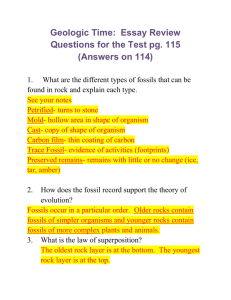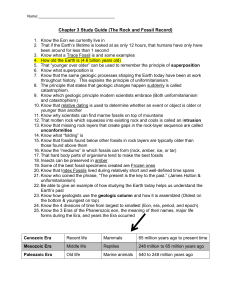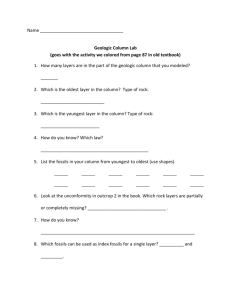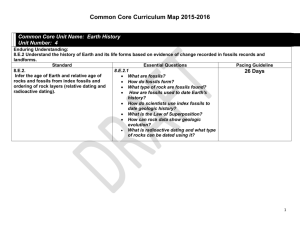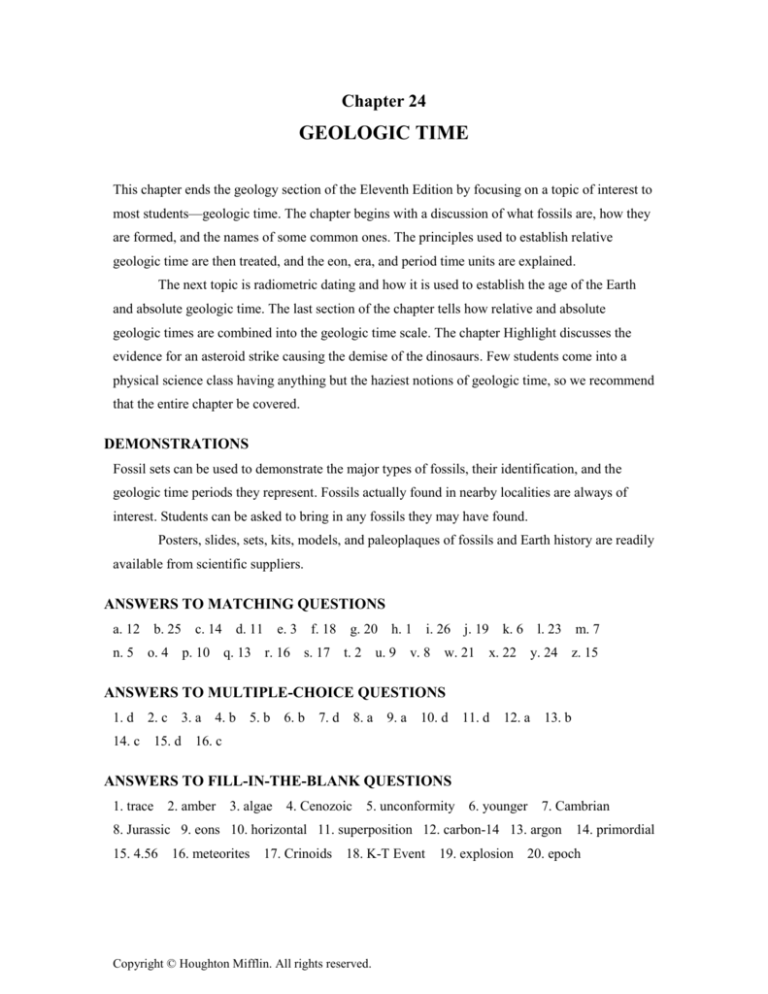
Chapter 24
GEOLOGIC TIME
This chapter ends the geology section of the Eleventh Edition by focusing on a topic of interest to
most students—geologic time. The chapter begins with a discussion of what fossils are, how they
are formed, and the names of some common ones. The principles used to establish relative
geologic time are then treated, and the eon, era, and period time units are explained.
The next topic is radiometric dating and how it is used to establish the age of the Earth
and absolute geologic time. The last section of the chapter tells how relative and absolute
geologic times are combined into the geologic time scale. The chapter Highlight discusses the
evidence for an asteroid strike causing the demise of the dinosaurs. Few students come into a
physical science class having anything but the haziest notions of geologic time, so we recommend
that the entire chapter be covered.
DEMONSTRATIONS
Fossil sets can be used to demonstrate the major types of fossils, their identification, and the
geologic time periods they represent. Fossils actually found in nearby localities are always of
interest. Students can be asked to bring in any fossils they may have found.
Posters, slides, sets, kits, models, and paleoplaques of fossils and Earth history are readily
available from scientific suppliers.
ANSWERS TO MATCHING QUESTIONS
a. 12
b. 25 c. 14 d. 11 e. 3 f. 18
g. 20 h. 1 i. 26 j. 19
n. 5 o. 4 p. 10 q. 13 r. 16 s. 17 t. 2 u. 9 v. 8
w. 21
k. 6
x. 22
l. 23 m. 7
y. 24 z. 15
ANSWERS TO MULTIPLE-CHOICE QUESTIONS
1. d 2. c 3. a 4. b 5. b 6. b
14. c
7. d
8. a
9. a 10. d 11. d 12. a 13. b
15. d 16. c
ANSWERS TO FILL-IN-THE-BLANK QUESTIONS
1. trace 2. amber
3. algae
4. Cenozoic
5. unconformity 6. younger
7. Cambrian
8. Jurassic 9. eons 10. horizontal 11. superposition 12. carbon-14 13. argon 14. primordial
15. 4.56 16. meteorites 17. Crinoids 18. K-T Event
Copyright © Houghton Mifflin. All rights reserved.
19. explosion 20. epoch
ANSWERS TO SHORT-ANSWER QUESTIONS
1. Geologic time is the time span since the formation of planet Earth.
2. Amber is fossilized tree resin.
3. Shells of shallow-water marine organisms endure well and are easily buried in sediment that
may eventually become sedimentary rock.
4. Replacement fossil.
5. Petrified wood.
6. Coal.
7. When an embedded shell or bone is dissolved completely out of a rock, it leaves a hollow
depression called a mold. If new mineral material fills the mold, it forms a cast of the original
shell or bone.
8. Fossils of blue-green algae, or cyanobacteria, date back to about 3500 m.y.a.
9. Layers of rock that contain certain microfossils, such as some species of Foraminifera, indicate
the presence of nearby oil deposits.
10. Trace fossil.
11. In a sequence of undisturbed sedimentary rocks, lava, or ash, each layer is younger than the
layer beneath it. Example: If lava A covers rock layer B, A is younger than B.
12. Layers of ash, lava, and sediments are originally deposited in horizontal layers.
13. Igneous rock, or a fault, is younger than the rock layers it has intruded or affected. Example: If
igneous dike A cuts through rock layer B, it is younger than B.
14. An unconformity is a gap, or break, in the rock record at a given locality due to nondeposition
or erosion.
15. Correlation is the process of matching up rock layers in different localities by use of index
fossils or other means.
16. Index fossils.
17. Typical of a particular limited time segment, widespread, numerous, easily identified.
18. Relative geologic time refers to the placement of rocks, and the geologic events they record, in
chronological order without regard to actual dates.
19. Paleozoic, Mesozoic, Cenozoic.
20. Seven, Permian.
21. Triassic, Jurassic, Cretaceous.
2
22. Tertiary, Quaternary.
23. Carbonaceous period.
24. Precambrian time is the huge span of time before the Cambrian period of the Paleozoic era, that
is, the time before the Phanerozoic eon.
25. Argon-40.
26. Rubidium-87.
27. Carbon-12.
28. No addition or subtraction of the parent or daughter has occurred over the lifetime of the rock
other than that caused by radioactive decay. The age of the rock does not differ too much
from the half-life of the parent radionuclide. None of the daughter element was present in the
rock when it was formed, or if it was, it is possible to tell how much.
29. Lead that comes from radioactive decay is called radiogenic lead, whereas lead that does not is
called primordial lead.
30. If no lead-204 is present, all the lead is radiogenic.
31. Meteorites from the asteroid belt date back to 4600 m.y.a., the oldest Moon rocks date back
4550 m.y.a., and the oldest known Earth rocks date back 4000 m.y.a. All these parts of the
solar system are thought to have formed about the same time.
32. The oldest known Earth rocks date back 4000 m.y.a.; the oldest Moon rocks date back 4550
m.y.a.
33. By dating igneous rocks that intrude or cover sedimentary layers and then using the law of
superposition.
34. The Hadean eon starts at Earth’s formation; the Archean eon starts at earliest known Earth
rocks; the Proterozoic eon starts at the formation of the North American continental core.
35. Cenozoic (65 million years).
36. Cenozoic era, Quaternary period, Holocene epoch.
37. The Paleozoic and the Mesozoic.
38. The end of the Ice Ages (last retreat of glaciers from North America and Europe).
39. Earliest fossils of the genus Homo.
40. The Cambrian explosion.
41. The K-T event.
3
42. Unusually high concentrations of iridium, shocked quartz, and soot in layers of rock from 65
m.y.a. indicate an asteroid impact. A large impact crater is found at Chicxulub that dates
from 65 m.y.a. (Any two pieces of evidence are a sufficient answer.)
43. A large impact crater is found at Chicxulub that dates from 65 m.y.a. and which may be the site
of the impact that caused the extinction of the dinosaurs and many other species.
44. 544 m.y.a. to 248 m.y.a.
45. A single supercontinent would allow land creatures to slowly distribute themselves all over the
continent, due to relatively short distances and lack of sea barriers.
ANSWERS TO APPLYING-YOUR-KNOWLEDGE QUESTIONS
1. These fossils are from the Paleozoic era and are between 544 and 248 million years old.
2. A cow bone was probably not deposited during prehistoric times, because cows are recent
species.
3. The last of the dinosaurs died out 65 m.y.a., whereas the oldest Homo fossils known only date
to about 2 m.y.a. So a huge 63-million-year gap seems to exist between the last dinosaurs
and the earliest humans.
4. The amber itself is prehistoric petrified tree resin, so it is a fossil whether or not an insect is
embedded in it.
5. Dinosaurs lived from about 245 to 65 m.y.a., but carbon dating can only date materials younger
than about 75,000 y. Perhaps carbon dating was confused with another type of radiometric
dating.
ANSWERS TO EXERCISES
1. (a) Mississippian, Pennsylvanian, Permian.
(c) Platycrinites and Lingula.
2. (a) Ordovician and Silurian.
(b) Silurian.
(d) Elrathia.
(b) Devonian. (c) Phacops, Zygospira, and Lingula.
(d) Neither lived during that period. (e) Elrathia.
3. (a) A is the younger; superposition.
(b) E is the younger; cross-cutting relationships.
4. (a) D is the younger; cross-cutting relationships. (b) E is the younger; cross-cutting
relationships.
5. About 11,460 years old.
6. About 17,190 years old.
4
7. Older than 210 My but younger than 245 My.
8. The rock must be between 410 My and 350 My old, the time period during which both fossils
lived.
ANSWERS TO VISUAL CONNECTION
a. eras
b. Cenozoic c. Quaternary d. epochs
5





